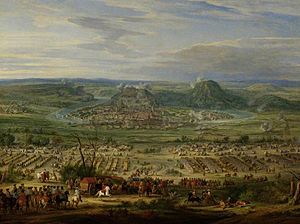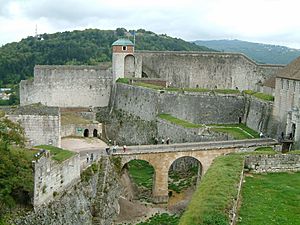Siege of Besançon facts for kids
Quick facts for kids Siege of Besançon |
|||||||
|---|---|---|---|---|---|---|---|
| Part of the Franco-Dutch War | |||||||
 A picture showing the siege of Besançon. On the right, you can see smoke from cannons. |
|||||||
|
|||||||
| Belligerents | |||||||
| Commanders and leaders | |||||||
| Strength | |||||||
| 15,000–20,000 | 3,300 regulars 1,500 city militia |
||||||
| Casualties and losses | |||||||
| 700–1,000 | Minimal | ||||||
The siege of Besançon happened during the Franco-Dutch War. This war was fought between France and a group of other European countries. The siege took place from April 25 to May 22, 1674.
During this time, French forces, led by King Louis XIV, attacked Besançon. Besançon was then part of the Spanish Empire.
A famous French military engineer named Vauban helped plan the attack. The city's defenders were led by Prince Vaudémont. Besançon was in a difficult spot, so its defenders could only delay the French.
After the siege, Besançon became part of France. This was decided by the Treaties of Nijmegen in 1678. Besançon then became the main city of the region.
Why the Siege Happened
In 1667, France fought the War of Devolution. France took over many areas, including Franche-Comté, where Besançon is located. But other countries formed an alliance. This group, called the Triple Alliance, made France give back most of these lands.
King Louis XIV of France then planned to attack the Dutch Republic directly. In May 1672, French forces invaded the Dutch Republic. At first, it looked like France would win easily. But the Dutch fought back, and the situation became stable.
Other countries worried about France's growing power. In 1673, the Dutch Republic, Brandenburg-Prussia, the Holy Roman Empire, and Spain formed an alliance. Denmark joined them in 1674. England also made peace with the Dutch.
France had to fight on many fronts. By the end of 1673, French troops left most of the Dutch Republic. King Louis XIV then decided to focus on Franche-Comté. French forces captured nearby towns like Gray and Vesoul in February 1674.
Vauban, the military engineer, convinced the French Minister of War to attack Besançon first. He believed it was the most important target.
The Attack on Besançon
After France captured Besançon in 1667, Vauban made plans to make its defenses stronger. When the city was given back to Spain in 1668, Spain used his plans. However, Spain did not have enough money. They also had to rebuild defenses in other towns.
Because of this, the outer walls and the main fortress, called the Citadel, were not finished by 1674. Besançon's defenses were split. There was the outer 'City' where people lived and worked. Then there was the inner 'Citadel,' a strong fort.
The city's soldiers were led by a Spanish officer. But the overall command was held by Prince Vaudémont. This was because Besançon was a Free Imperial City of the Holy Roman Empire. This meant it had some independence.
A French army of 15,000 to 20,000 soldiers arrived on April 25. They were led by Duc d'Enghien. Most of these troops were placed around the city's suburbs.
The attack started on April 26. Vauban directed the operations. He knew the city's defenses well from his earlier work. Besançon is located on the River Doubs, which flows through the town.
French soldiers built trenches and earthworks near the river. After a lot of hard work, they placed their cannons on hills. These hills, called Chaudanne and Bregille, overlooked the city. The bombing of Besançon began on May 1.
King Louis XIV arrived at the French camp the next day. Kings often visited sieges to show their power. Louis helped place the artillery batteries. He was even exposed to enemy fire from the city. One shot killed a staff member near him.
By May 6, the cannons were all in place. The city was then bombed constantly from five different spots. The Chamar area of the city had to be flooded. This was done to stop French attacks on May 6/7 and May 8/9.
The French attackers lost many soldiers. Vauban later said these losses could have been avoided. He believed they were mainly to impress King Louis. However, the defenders could not fight back effectively. There was also no hope of help arriving for them.
By May 13, the city walls near the Arènes gate were broken in several places. Back then, if a city kept fighting after its walls were breached, the attackers could destroy and rob the city. On May 14, the city leaders asked to surrender. King Louis agreed, and he entered the city on May 15.
The Citadel, the strong inner fort, held out for another week. It fought off an attack on May 20. But the soldiers inside had no chance of winning. Two days later, Prince Vaudémont surrendered. He and 800 other survivors were allowed to leave safely.
What Happened After
On May 27, King Louis left Besançon. He then moved on to Dole, which was already being attacked. Dole surrendered on June 7. Salins-les-Bains surrendered on June 10.
With these victories, France had taken over the whole region. Many French soldiers were then sent to fight in the Spanish Netherlands. They fought in the Battle of Seneffe in August.
In 1676, Besançon became the main city of the region. The Regional Parlement, a type of court, was moved there. The area remained a bit unsettled. There were small groups of fighters, called loups de bois, causing trouble. Also, Imperial troops from the Holy Roman Empire were fighting nearby.
The war was very expensive. This led to arguments about taxes and money. The leaders in Besançon were told to fix the damage from the siege. But they refused, saying the French King should pay. When they were forced to do the work, they did it very slowly. Similar arguments happened about supplying the French soldiers.
During the siege, a French army surgeon named Étienne Morel used a tourniquet. This tool helps stop bleeding from injuries. It was one of the first times this technique was used in battle.
See also
 In Spanish: Asedio de Besanzón para niños
In Spanish: Asedio de Besanzón para niños
- Louis XIV Victory Monument
Sources
(French);


